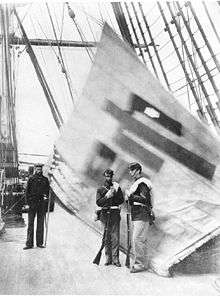Sujagi
The Sujagi is a flag with a Hanja (Chinese ideogram) 帥, pronounced su in Korean, that denotes a commanding general. The whole term literally means, "Commanding general flag". Only one sujagi is known to exist in Korea. The color is a faded yellowish-brown background with a black character in its center. It is made of hemp cloth and measures approximately 4.15m x 4.35m.[1]


| Sujagi | |
.jpg) Sujagi captured in 1871 | |
| Korean name | |
|---|---|
| Hunminjeongeum | 수자기 |
| Hanja | 帥字旗 |
| Revised Romanization | Sujagi |
| McCune–Reischauer | Sujagi |
History
This type of flag was put in a fortress where a commanding general was located.[2] In the case of the extant sujagi in Korea, it represented General Eo Jae-yeon who, in 1871, commanded the Korean military forces on Ganghwa Island, which is off the northwest coast of present-day South Korea, nearby the capital of Seoul. It was captured by the United States Asiatic Squadron in June of that year during the United States' expedition to Korea.[3] As with other war prizes, it was put into the collection of the museum at the United States Naval Academy in Annapolis, Maryland.
In October 2007, after many years of petitioning the United States government, the flag was returned to South Korea on a long-term, ten-year loan. It is currently housed at the National Palace Museum of Korea in Seoul.[4][5]
Notes
- "신미양요 때 빼앗긴 어재연 장군기 '10년 장기대여' 귀환 : 뉴스". 23 October 2007. Retrieved 1 May 2017.
- http://museum.kma.ac.kr/museum/image/ama/ama081002.jpg
- Carolyn A. Tyson (1 January 1966). Marine Amphibious Landing in Korea, 1871. Naval Historical Foundation. Retrieved 27 January 2015.
- Chung Ah-young (22 October 2007). "General's Flag Returns Home From US". Korea Times. Retrieved 27 January 2015.
- Bradley Olson (11 October 2007). "Korean flag to be returned on loan basis". Baltimore Sun. Retrieved 27 January 2015.
See also
- History of Korea
- Military history of Korea
- Joseon Dynasty